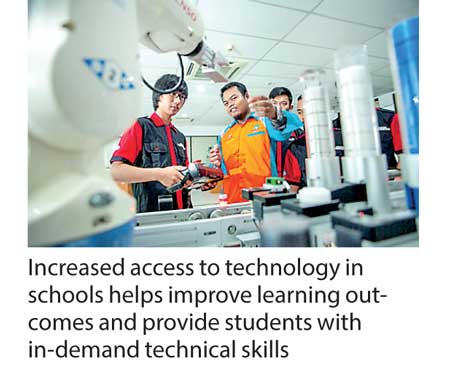Saturday Apr 20, 2024
Saturday Apr 20, 2024
Friday, 21 July 2017 00:00 - - {{hitsCtrl.values.hits}}

A variety of new approaches to education and skills development have emerged in recent years. The 2016 International Skills Forum, organised by the Asian Development Bank, featured some of the best practices, which ranged from partnerships with the private sector to adoption of technology to new modes of delivery for education. And they all have a common goal: to strengthen the foundation of higher education and technical vocational education and training, or TVET.
Universities are significant generators of new knowledge. They produce highly skilled workers and help foster innovation across different sectors. Successful models of linkages have supported innovation through research, use of technology, and business incubation (commercialising products) in partnership between universities and industries.
Universities can contribute to economic development through research, community engagement, the generation of new ideas for products, and discovery of new ways to increase productivity.
For example, in the People’s Republic of China, Microsoft has forged partnerships with the information technology (IT) department of several universities. The American multinational technology company sends senior staff to the universities as part-time lecturers and offers job placements for IT students.
Technology has played a big role in engaging stakeholders and expanding the reach of education. With the increasing reach of the internet and the widespread use of various technological devices, such as computers, tablets and smartphones, it has become crucial to use technology in education.
For example, blended and e-Learning broadens teaching and learning by providing additional tools to explain complex issues or retain student attention. They also enable students to learn anywhere and anytime as well as learn from experts from any part of the world.
There is an increasing emphasis on education and the world of work through work-integrated-learning, career development, and ensuring skills development matches the needs of the emerging workforce.
Governments across Asia and the Pacific are looking for more effective ways to engage industry in skills development so they can ensure they have competitive, productive, and job-ready workers.
New methodologies in teaching and learning encompass innovations in online education technology, which was triggered by the revolution in information and communications technology and the widespread use of the internet.
New modes of delivery, such as massive open online courses, or MOOCs, have changed the education landscape, improved learning outcomes and provided greater access in equitable and cost-effective ways.
School-to-work transition is a training program, such as on-the-job trainings and apprenticeships, aimed at preparing high school students or out-of-school youths for the labor market.
In the Philippines, the JobStart program, which provides career guidance, coaching, and life skills training to unemployed youth, is an example of a national school-to-work transition program.
A version of this article first appeared on Development Asia, ADB’s new website for learning and collaboration that makes it easier to create, share, and use practical development know-how.